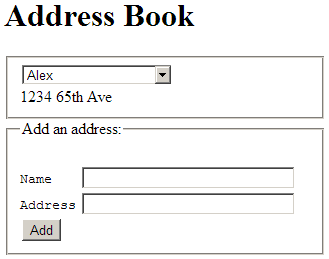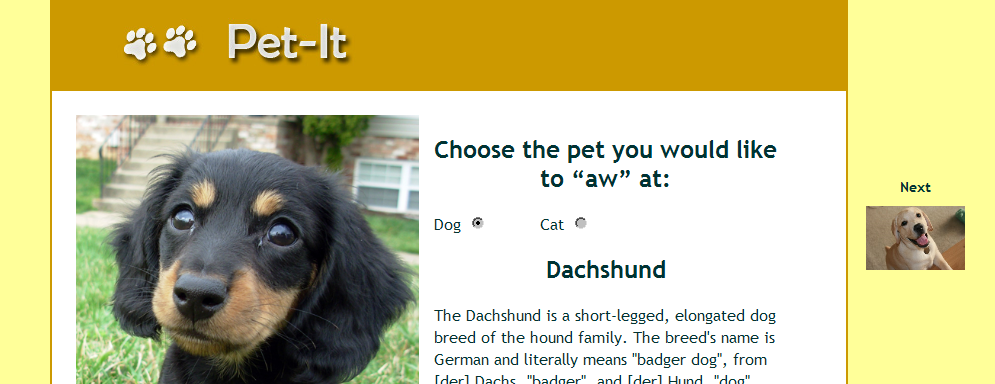University of Washington CSE 154
Section 8: Ajax & Web Services
Except where otherwise noted, the contents of this document are Copyright © Marty Stepp, Jessica Miller, and Victoria Kirst. All rights reserved. Any redistribution, reproduction, transmission, or storage of part or all of the contents in any form is prohibited without the author's expressed written permission.
Recall: Ajax template
var ajax = new XMLHttpRequest();
ajax.onload = functionName;
ajax.open("GET", "url", true);
ajax.send();
...
function functionName() {
if (this.status == 200) { // request succeeded
do something with this.responseText;
} else {
code to handle the error;
}
}
Exercise : Ajax Pets (by Alex Miller)
Create an AJAX-powered gallery of pet images that allows you to switch between kitty and puppy images without reloading the page. You can view the finished product here.
You are provided with the following HTML file, ajaxpets.html:
You must write a JavaScript file ajaxpets.js which requests data
from the ajaxpets.php script on webster with the parameter animal of value kitty or puppy, depending on which radio button is selected, and injects this into the #pictures div.
Exercise Solution
window.onload = function() {
document.getElementById("puppies").onclick = updatePictures;
document.getElementById("kitties").onclick = updatePictures;
};
function updatePictures() {
var animal = "";
if (document.getElementById("puppies").checked) {
animal = "puppy";
} else {
animal = "kitty";
}
var url = "//webster.cs.washington.edu/cse154/sections/ajax/pets/ajaxpets.php?animal=" + animal;
var ajax = new XMLHttpRequest();
ajax.onload = displayPictures;
ajax.open("GET", url, true);
ajax.send();
}
function displayPictures() {
document.getElementById("pictures").innerHTML = this.responseText;
}
Exercise : Boot Loader (by Morgan Doocy)
Write a "Boot Loader" page that displays a randomly chosen fashionable boot when the "Load Boot" button is clicked. Start from this HTML skeleton. (sample solution)
-
Write the JavaScript code to make an Ajax request to
loader.phpon Webster when the 'Load boot' button is clicked. - The PHP service does not require any query parameters. Its output is simply a string containing a URL of an image of a random boot image to display.
-
Whatever URL the loader service returns, inject a new
imgtag into the page that points to that image.
Exercise extra features
-
The PHP service is slow; it takes 2-3 seconds to return the boot output.
Make the page look better while it is waiting by temporarily displaying a "loading" animation.
The page contains an element with
idofloadingthat can be used to show an animated image while the page is waiting. Set itsdisplayDOM CSS property appropriately. -
The PHP service is flaky; every 5-6 requests, it crashes with an HTTP error 500.
Make your page check for this and display an
alerton errors so the user knows something went wrong. Don't try to display the boot image when there is an error.
Exercise Solution
You can view the solution javascript file here.
Exercise : Chat-It (by Eli White)
Given this HTML skeleton, write the necessary JavaScript code to make the page into a chat program.
Read and submit chat messages by making Ajax requests to the provided
(chatit.php) on Webster.
(sample solution)
-
Reading: every 5 seconds, make an Ajax
GETrequest to ask the PHP script for all messages. Optional parameters:reversereturns output in reverse-chronological order;limitreturns only that many most recent posts -
Submitting: When the 'Send!' button is clicked, make an Ajax
POSTrequest to the PHP script with the parametermsgto submit a message. (see next slide and/or Ajax POST slides)
Creating an Ajax POST request
var params = new FormData();
params.append("name", value);
params.append("name", value);
var ajax = new XMLHttpRequest();
ajax.onload = functionName;
ajax.open("POST", "url", true);
ajax.send(params);
- use a
FormDataobject to gather your POST query parameters - pass the
FormDatato the request'ssendmethod methodpassed toopenshould be changed to"POST"
Exercise Solution
You can view the solution JavaScript code here.
Exercise : Recipes (by Roy McElmurry)
Given this HTML file,
write an accompanying recipe.js that displays recipe information on
the page with ajax. When a radio button is clicked make an ajax GET request to
recipes.php
with a parameter r that has the value of the radio button.
The results from recipes.php is in xml format. You must parse the
results and fill the #main div with with a h1 containing the title,
an img tag with the recipe's image and a ul filled with the recipe's ingredients.
Check out a working example here.
Exercise : Recipes
The result xml from recipes.php has the following structure (and some extra stuff):
<recipe> <information> <name></name> <image></image> </information> <ingredients> <item amount=""></item> ... </ingredients> <directions> <step></step> ... </directions> </recipe>
Exercise Recipes
You can view the solution javascript here.
Exercise : Pet-It (by Stefanie Hatcher)
Today we will write a page "Pet-It" that shows information about breeds of cats and dogs using Ajax. The HTML and CSS are already written; start from them:
Add the JavaScript event-handling and Ajax code. Click the following image to run
our sample solution:
(solution JS code petit.js)
Exercise : Pet-It
All required files are on Webster
http://webster.cs.washington.edu/cse154/sections/ajax/,
or you can download them as pet-it.zip.
Breeds are located in the subdirectory breeds/ relative to the previous URL.
-
Part 1: When the user selects "Dog" or "Cat", show a bulleted
list of all breeds. Lists of breeds are stored on the server in files named
dogs.txtandcats.txt. -
Part 2: When the user selects "Dog" or "Cat", show the image
and info about the first breed. Each breed has an HTML and JPG file on the
server; for example, Chow Chow has
breeds/chow_chow.htmlandbreeds/chow_chow.jpg.
Exercise : Pet-It
-
Part 3: When the user clicks "Next", advance to the next breed. Highlight the current breed (give its list item the class
selected). If the user reaches the last breed and clicks Next, wrap around to the start. - Other: If you finish all of the previous features, make it so that you can click any breed in the list to jump to info about that breed. Or make a "Previous" area (much like "Next") that allows the user to go back to the last breed.
Exercise Solution
You can view the solution javascript here.
Exercise : Address Book, Client-Side (by Alex Miller)

Write the JS code to connect to a server-side JSON address book called
addressbook.php.
Start from this HTML.
(sample solution)
(solution)
-
A GET request to
addressbook.phpwith no parameters outputs an array of names:{"names": ["Suzie", "Billy", ...]} -
A GET request with a
nameparameter outputs that person's address:{"name": "Billy", "address": "123 4th St."} -
A POST request with a
nameandaddressparameter saves that person in the address book.
Exercise : Address Book, Server-Side (by Alex Miller)

Write the PHP code to manage an address book using JSON.
You are given the HTML and JS.
The JS code sends requests to your addressbook.php web service that reads and saves address data.
(sample solution)
(solution)
Write the PHP file, addressbook.php, that provides the following behavior:
-
A GET request to
addressbook.phpwith no parameters outputs an array of names:{"names": ["Suzie", "Billy", ...]} -
A GET request with a
nameparameter outputs that person's address:{"name": "Billy", "address": "123 4th St."} -
A POST request with a
nameandaddressparameter saves that person in the address book.
You may assume that any necessary parameters are passed and are in valid formats.
Exercise : Prime Factors XML (by Eli White)
Write a PHP web service factors-xml.php that computes and outputs prime factorization of integers as XML.
(sample solution)
(solution code)
Provide the following behavior:
-
A GET request to
factors.phpwith annparameter outputs the prime factors of that integer. For example, the requestfactors.php?n=264would output:<integer value="264"> <factor>2</factor> <factor>2</factor> <factor>2</factor> <factor>3</factor> <factor>11</factor> </integer>
One algorithm for prime factorization of
nis to loop through each integer i from 2-n, and for each time n is divisible by i, add i to your list of prime factors. -
A GET request without a proper
nparameter should return an HTTP error code 400 (Invalid Request) with an instructive error message.
Exercise : Prime Factors JSON (by Eli White)
Write a PHP web service factors-json.php that computes and outputs prime factorization of integers as JSON.
(sample solution)
(solution code)
Provide the following behavior:
-
A GET request to
factors.phpwith annparameter outputs the prime factors of that integer. For example, the requestfactors.php?n=264would output:{"value": 264, "factors": [2, 2, 2, 3, 11]}One algorithm for prime factorization of
nis to loop through each integer i from 2-n, and for each time n is divisible by i, add i to your list of prime factors. -
A GET request without a proper
nparameter should return an HTTP error code 400 (Invalid Request) with an instructive error message.


